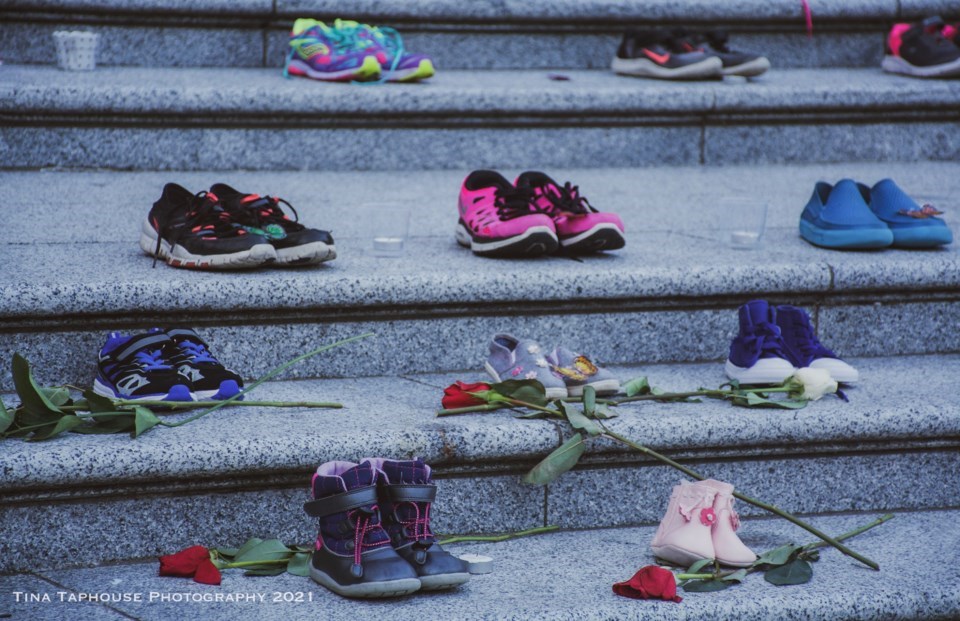The Goal of a Residential School: “We instill in them a pronounced distaste for the native life so that they will be humiliated when reminded of their origin. When they graduate from our institutions the children have lost everything Native except their blood.”
- by Bishop Grandin, 1875
There are no words to describe the horror and soul-deep grief I felt when the news broke several days ago about the discovery of the remains of 215 children in a mass grave at the Indian Residential School in Kamloops, which operated under the Catholic church for 79 years starting in 1890.
As a mother of two I made myself imagine what it would feel like to have my children ripped from me, and then to lose them altogether without it ever being recognized or acknowledged.
I would never recover from that.
In imagining my level of grief, I reached out to Lil’wat Chief Dean Nelson and when we spoke it felt like every word I said was meaningless because I, indeed all settlers, bear responsibility for this, and the uttering of words has not effected any meaningful changes for First Nations people so far.
Said Chief Nelson by email: “To hear the breaking news of the finding of the two hundred and fifteen children at the former Kamloops Indian Residential School has been traumatic all over again especially for direct survivors.
“To put this into perspective, imagine for a minute your children, your nieces, nephews, and grandchildren were taken and were never to return home.”
Please, go ahead… take a minute to imagine that.
While it may be years before experts, in a culturally sensitive manner, are able to identify the remains and share the stories of the children, knowing that the Lil’wat people had their children taken to the Kamloops school, as well as others, brings this tragedy home to us.
Indeed, I would argue that the people of Canada woke up changed the day the news of this mass grave was shared—at least I hope they did.
As descendants of colonizing powers we are all implicated in the plan to culturally eradicate the First Peoples of what we call Canada.
As we talked, Chief Nelson said: “The biggest thing from the general public would be the understanding of it all, not to view it in a biased place. It has to be understood for what it was—it was genocide. That is a tough thing to swallow, but that is what it is.
“But it is still here—the intergenerational trauma is still here, and we wrestle with it daily.”
While the news of this mass grave was shocking to many, it was not news to First Nations, who have been sharing the story of the hundreds (perhaps thousands) of missing children for decades.
We know from the Truth and Reconciliation Commission (TRC) that 4,118 students died while attending residential schools in Canada, as they have been identified. But the real number is believed to be considerably larger. However, with many of the records stashed at the Vatican and the Pope refusing to formally apologize, we may never know where and who these missing children are.
And we need to know. We need to put names to their faces and learn their stories, and as Chief Nelson said, we really need to understand in order for the dehumanization of First Nations people to stop.
Recommendations 71 to 76 of the TRC call for the Canadian government and other stakeholders to find the graves of the missing children, and work is ongoing, but it is so slow as to be almost meaningless to survivors waiting for news of the fate of loved ones.
How can we move forward from this place of shame and grief? How can we be partners in healing instead of perpetrators of harm?
Chief Nelson believes we can move forward, but that in order to do so the Indian Act must be struck down.
“I was asked what would be the greatest thing to make a difference and it would be the freedom to help ourselves, we would not be under the Indian Act, where we have to live by guidelines of Indian Affairs,” he said, his voice heavy with frustration and resignation.
First Nations people will find their voice, their power, when they have the opportunity and authority to help their own people according to their own laws and traditions and culture.
This means real action on the part of government and understanding and partnerships among all residents of Canada.
I believe this is possible.
So, I am not offering more words. I am committing to take what actions I can to fight settler supremacy and to work to understand the story of the Lil’wat and other nations—and to share it as well.





